 Narrowsburg
NarrowsburgLight Rain Fog/Mist, 43°
Wind: 8.1 mph
 Narrowsburg
NarrowsburgHONESDALE, PA — This was the Christmas that Glen Lee was able to wear dog tags again. He lost his, in another place, long ago. Several months ago, he told Deby Gumpper about the loss. And it …
Stay informed about your community and support local independent journalism.
Subscribe to The River Reporter today. click here
This item is available in full to subscribers.
Please log in to continue |
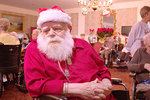
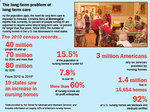
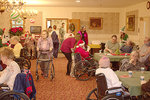
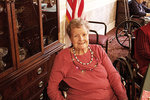
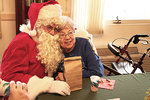
HONESDALE, PA — This was the Christmas that Glen Lee was able to wear dog tags again.
He lost his, in another place, long ago. Several months ago, he told Deby Gumpper about the loss. And it hurt her. Lee is so proud of his 46 months in the Air Force─that’s how he puts it, “forty-six months”─and it seemed wrong that he should go without a touchable memory of that time.
Gumpper is a transportation aide at Ellen Memorial Health Care and Rehabilitation near Honesdale. Owned by the Zabady family, the 130-bed facility has been in business since 1976 and offers skilled nursing, rehabilitation, dementia care and hospice. It took six months to track down dog tags, Deby Gumpper said at the hospice’s December 21 holiday party, which included cookies and a visit from Santa.
She presented Lee with the shiny metal tags attached to a package of socks. It took a while to get them on over the tube to his oxygen tank, but eventually they maneuvered them around Lee’s neck, and he spoke proudly about his time in the service, now and then reaching up to touch the tags. Then he gave Gumpper a small but radiant smile.
For many people, the last years of life aren’t necessarily pretty—memory goes and family becomes unrecognizable. For others, the ability to move or use the toilet means depending on caregivers for activities you’d rather do in private. Sometimes pain blinds you to everything else, or medication wraps the world in fog. Nursing home staff are trained to deal with the elderly or residents who are disabled and prone to fits of frustration, sometimes taking it out on their caregivers.
As the population ages, the need for long-term care is expected to increase. For one, the “baby boom” generation of people born between 1946 and 1964, is reshaping America’s aging population. “The aging of the baby boom generation could fuel a 75 percent increase in the number of Americans ages 65 and older requiring nursing home care,” reads a report from the Population Reference Bureau. The 2010 census records roughly 40 million people 65 and up. That number is projected to increase to 70 million by 2030 and more than 80 million by 2050.
And that’s only the folks 65 and older. Others who need round-the-clock care include people with disabilities and those who are chronically ill.
We’re also living longer. The average age of death in the United States, according to the National Center for Health Statistics, is about 78 years old.
To cater to this population, in 2017, the CDC reported 15,600 nursing homes (higher level medical care) with 1.4 million residents.
Jobs in healthcare are similarly becoming more necessary. According to the Bureau of Labor Statistics, 2.8 million jobs were added in the healthcare sector between 2008 and 2016, seven times faster than the rest of the economy. Staff at Ellen Memorial, throwing a festive celebration for upwards of 50 residents—some of whom didn’t have families to celebrate with this Christmas—dressed as elves and delivered gifts from Santa’s sleigh (grey, reindeerless and on wheels, but who cared? Nobody).
Santa himself cruised around the room, dispensing hugs. Residents beamed from their wheelchairs, parked at tables, or from reclining chairs off to the side. Those family members who could make it to the party sat near their loved ones, laughing and checking out the presents. Staff members bent down to embrace the frail, carefully, as if these friends were made of blown glass.
Most residential care offers options based on level of care needed: assisted living (including group homes), skilled nursing and nursing homes. Residence can be permanent, or temporary, for post-stroke or post-surgical rehab or physical therapy.
Some places offer cooked meals, social activities and a little oversight for a loved one who is in good health but prefers not to live on his or her own anymore. Other levels of care help with many activities of daily living like bathing or monitoring medication. Some facilities care for people who are mentally ill. Some for those who have disabilities or dementia. Some work with hospice to care for the dying. Residents can move from one level of care to another, for example, shifting from assisted living to memory care as needs change.
“This is the best place,” said retired surgical technician Anne DiLella. “I never wanted my kids to have to worry about me. The owner treats us like his own family.” For instance, last year she created her own garden on the property. At the party, she held up a cookie that the residents helped bake for the party. “We made these.”
“Well, staff was supervising,” put in resident Lisa Taylor, seated at the same table. There are other opportunities to have fun, she said. “We have birthday parties, they take us out to breakfast.”
An elf came by, handing out gifts. Santa boomed from across the room, greeting somebody. “There’s no other place in the world like this,” DiLella said. Taylor nodded, agreeing.
A few tables over, Rhoda Dutton Dewey touched her gift, a necklace that flashes with colored LED lights. “This has been a delightful party. We had Santa Claus and his father, Retired Santa.” Everyone at the table laughed, and she admired her neatly-decorated cookie, delivered by a young volunteer.
By “Retired Santa,” Dewey meant Glen Lee, the Air Force veteran, who worked for the post office for 30 years after his military service. Lee, with his big white beard, had dressed for the party in a Santa hat and red shirt. The other Santa continued to circulate, pausing to visit with a lady in a reclining chair, who did not speak, her gift unwrapped in her lap. Staff stopped by too, touched her hand, met her eyes and smiled.
For more information on seniors in the U.S., see the info box below.
Comments
No comments on this item Please log in to comment by clicking here